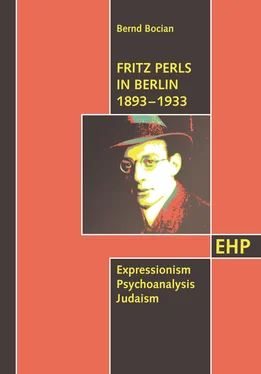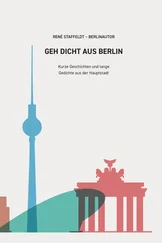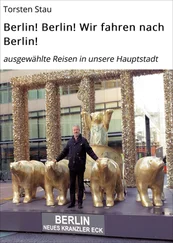Bernd Bocian - Fritz Perls in Berlin 1893 - 1933
Здесь есть возможность читать онлайн «Bernd Bocian - Fritz Perls in Berlin 1893 - 1933» — ознакомительный отрывок электронной книги совершенно бесплатно, а после прочтения отрывка купить полную версию. В некоторых случаях можно слушать аудио, скачать через торрент в формате fb2 и присутствует краткое содержание. Жанр: unrecognised, на английском языке. Описание произведения, (предисловие) а так же отзывы посетителей доступны на портале библиотеки ЛибКат.
- Название:Fritz Perls in Berlin 1893 - 1933
- Автор:
- Жанр:
- Год:неизвестен
- ISBN:нет данных
- Рейтинг книги:3 / 5. Голосов: 1
-
Избранное:Добавить в избранное
- Отзывы:
-
Ваша оценка:
- 60
- 1
- 2
- 3
- 4
- 5
Fritz Perls in Berlin 1893 - 1933: краткое содержание, описание и аннотация
Предлагаем к чтению аннотацию, описание, краткое содержание или предисловие (зависит от того, что написал сам автор книги «Fritz Perls in Berlin 1893 - 1933»). Если вы не нашли необходимую информацию о книге — напишите в комментариях, мы постараемся отыскать её.
Fritz Perls in Berlin 1893 - 1933 — читать онлайн ознакомительный отрывок
Ниже представлен текст книги, разбитый по страницам. Система сохранения места последней прочитанной страницы, позволяет с удобством читать онлайн бесплатно книгу «Fritz Perls in Berlin 1893 - 1933», без необходимости каждый раз заново искать на чём Вы остановились. Поставьте закладку, и сможете в любой момент перейти на страницу, на которой закончили чтение.
Интервал:
Закладка:
The shift from bourgeois humanism to bourgeois nationalism created one of the prerequisites for the subsequent rise of National Socialism. When the Nazis later referred to human kindness as nothing more than »humanistic mumbo jumbo,« they were expanding and radicalizing something pre-existing in this respect as well.
Naturally, the outcome of this transformation within the culture of the bourgeoisie was as yet unforeseeable. Many German Jews either did not notice the process or chose to look the other way for the sake of the hopes they held. It was simply inconsistent with their identity as important citizens of the cultural nation of Germany, where they felt thoroughly comfortable notwithstanding all of the discrepancies and setbacks. Even after the Nazis gained power in 1933, men like Martin Buber, philosopher and founder of cultural Zionism, and Leo Baeck, Chief Rabbi of Berlin, were still discussing how rooted Jews were in Germany; they experienced and described what loomed ahead as a »rending of organic ties« (Traverso 1993, 23).
As German Jews assimilated, they adopted early bourgeois-humanist views on education and mankind. As a consequence, many of the émigrés viewed themselves as representatives of the true German identity and a better Germany, which they defended against volkish distortion. They clung to the »idealized images of Schiller, Lessing, Goethe, 11Kant, and Herder« whom they »treated with reverence previously accorded only to the Old Testament patriarchs« (Bauman 1995, 126). Even in his old age, Fritz Perls continued to view Goethe as the personification of his ideal personality, the integrated personality, and in his youth he associated a thought of Schiller’s with a »peak experience« (Perls 1977, 45).
With respect to the history of German Jewry, its optimism about integration, and its love of a cultural Germany that was in part only imaginary, one can today speak of the »pursuit of a noble illusion« (Mosse 1992, 33). Or, tak ing the Auschwitz perspective, one could also speak of a grave abandonment of self and »emotional confusion« (Scholem 1995, 28). Nevertheless, I would like to discuss the positive implications of the humanistic view of mankind and its educational ideals for the development of Gestalt therapy.
2.3 The Humanistic Educational Ideal. Individuality and Holistic Personality Development
In most cases, Gestalt therapy is classified as a so-called humanistic orientation within the fields of psychology and psychotherapy. I suggest that this be traced not only to humanistic psychology, that is, the framework within which Gestalt therapy became popular years after its conception. Instead, we should follow its roots back to the significantly older tradition of bourgeois-humanistic education that was introduced into Gestalt therapy through Fritz and Lore Perls. The emphasis on personal growth that is so important for the Gestalt approach ensured the survival of the classical-romantic 12concept of education that continued to serve as an identity-generating touchstone for German Jews, especially the educated ones, even after they had emigrated.
Beginning in the middle of the 18 thcentury, a new humanistic movement arose in German-speaking countries. It built on Renaissance humanism and oriented itself on an idealized image of man in ancient Greece, and on »paideia,« the Greek educational ideal that focused on providing the individual with the most comprehensive physical, mental, and social education possible. Humanitarianism and comprehensive education formed an organic interrelationship within this body of thought, and in principle every person enjoyed a right to personality development and individual expression.
A specifically German concept of education began to emerge which then increasingly took on a nationalistic hue within the framework of the war of liberation against Napoleonic France. The preference for classical Greek literature (Homer, Pindar) over the Roman in connection with this was perceived as a »political declaration of war directed at Paris« (H. Blankertz 1992, 92). Yet in the work of Wilhelm von Humboldt, one of the most important representatives of neo-humanism, all anti-French sentiment was lacking, which allows us to view him as an exemplary representative of the classical German, cosmopolitan-humanistic tradition we refer to here.
The Humboldtian type of neo-humanism took sides with the individual, opposed the cooptation of the individual by society, and was against purely utilitarian thinking. 13Here, education was viewed as the path of individuality to itself, as an unending life-long task. The goal was to achieve humanness, beyond national, denominational, vocational/class designations and limita tions. Nobility did not arise automatically and exclusively through birth. Instead, individuals could ennoble themselves through education. Goethe and Schiller, the »princes of poetry,« portrayed these views in the field of literature. According to the basic tenor of the numerous »Bildungsromane,« life was an educational journey. »Humboldt viewed individuality as the formative inner power that man uses to transform what he grasps into his own nature« (Blankertz 1992, 101). This already comes very close to Gestalt therapy’s concept of assimilation, whereby the individual does not merely incorporate or adapt to the demands of the environment, but renders the initially alien material from the environment suitable in his or her own self-determined manner, both selecting and destructuring and thus achieving growth. In both cases, education implies activity of one’s own initiative, in other words, selfeducation. The ideal of personal wholeness or totality that was connected to the humanistic concept of education implies a whole that manifests itself in specific individual characteristics.
External form cannot and may not be imposed upon individuality from without. Accordingly, in »Wilhelm Meister’s Apprenticeship« Goethe encapsulated the humanistic educational ideal in the words »to educate myself, just as I am« (in Mosse 1992, 22).
After 1871, cosmopolitanism and the evolution of the individual personality as a process of autonomous, unending inner development became incompatible once and for all with a state that was attempting to create a mighty, unified empire. The object was to exclude everything that was non-German with respect to politics, religion, and race and to foster a mentality of subservience. After the founding of the German Empire in 1871, »when the Germans themselves had generally mutilated the original concept of education to the point of unrecognizability, for German Jews the concept became synonymous with their own Judaism« (Mosse ibid., 23). 14
2.3.1 Friedrich Schiller. The »Middle Mode« and »Living Gestalt« 15
The tendency to disdain physicality and sensuality which accompanied the Enlightenment, along with its one-sided preference for rationality and the intellect, provoked criticism and a counter-reaction within the Enlightenment itself. The concept of totality seen in early Romanticism, for example, was also directed against such fragmentation of life and can be read as a critique of the alienation phenomena that arose based on the division of labor in emergent industrial society.
Published in 1795, Friedrich Schiller’s letters, »On the Aesthetic Education of Man,« represent one of the central works on the classical German idea of humanness. Schiller addresses the topics under examination in the present monograph using terminology that was to re-surface at the end of the 1940s when Gestalt therapy was conceived in New York. This has to do with the fact that Gestalt therapy belongs to the tradition of self-critical enlightenment, represented by Schiller among others. 16In the letters, Schiller laments that the human being has been split into reason and sensuality, and he sets out in search of a »sensuous-rational nature« (Schiller 1965, 45). Schiller also describes the ordering reason, that is, the power of thought, as an »instinct to create form.« He refers to the object of that instinct as a »Gestalt« (shape and form), while »the object of the sensuous instinct« or of the passive »material impulse,« »is named life in the widest acceptation« (see ibid., 58 f.). On a very abstract level, Schiller sees a synthesis of both poles in the »play instinct,« a »middle state« (Hamburger in ibid., 147) he also refers to as the »aesthetic state.« Another term he uses to refer to this middle state, which can be experienced in the perception of beauty, is »lebende Gestalt« or »living form« (ibid., 59).
Читать дальшеИнтервал:
Закладка:
Похожие книги на «Fritz Perls in Berlin 1893 - 1933»
Представляем Вашему вниманию похожие книги на «Fritz Perls in Berlin 1893 - 1933» списком для выбора. Мы отобрали схожую по названию и смыслу литературу в надежде предоставить читателям больше вариантов отыскать новые, интересные, ещё непрочитанные произведения.
Обсуждение, отзывы о книге «Fritz Perls in Berlin 1893 - 1933» и просто собственные мнения читателей. Оставьте ваши комментарии, напишите, что Вы думаете о произведении, его смысле или главных героях. Укажите что конкретно понравилось, а что нет, и почему Вы так считаете.











